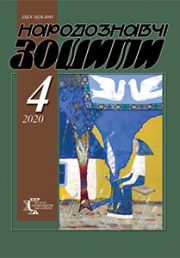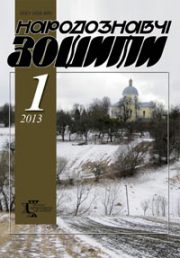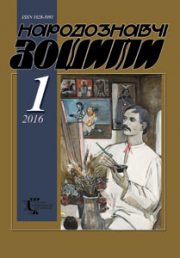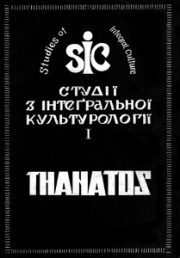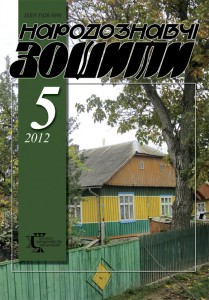2012 year, issue 5
Content
The article has presented some results of a research-work on symbolic role of honey in the context of the Ukrainians’ wedding ritualism and exposed main semantic connotations of the mentioned product, viz., its mediative, introductive, apothropaic, vitalizing, erotizing, fertilizing and magical procreative functions as well as its ritual meanings of sacrificial donation. The semantic sphere of wedding ritual has included quite active function of honey being distinct erotic-sexual marker, which could be discernable on a various stages of wedding – i.e. in engagement, korovay-loaves acting, weaving of wreathes or vinkopletiny, preparation of marriage temple ceremony, greeting of bride and bridegroom by parents, party at the bride’s home , komora rite and perezva, zavivannja of young lady.
Keywords: honey, wedding rites, semantics, mediator, erotic-sexual marker, Ukrainian context, European parallels.
Keywords: honey, wedding rites, semantics, mediator, erotic-sexual marker, Ukrainian context, European parallels.
On the ground of field research-works as well as possessed sources and scientific literature in the article have been considered some devices used by Polissian inhabitants in lighting their dwellings by means of burning the «luchinas», i.e. small pine-tree rods. Analytical study has been made as for constructive peculiarities of devices and dynamics in development of those as well as some ritual aspects related to «posvit». Cultural and genetic connections of lighting and heating devices of Polissian homesteads have been traced.
Keywords: ethnology, Ukraine, Polissia, «luchina», «posvit», open fire, stove, ritualism
Keywords: ethnology, Ukraine, Polissia, «luchina», «posvit», open fire, stove, ritualism
In the article have been presented and analyzed some source materials on the wedding rites, gathered by Polish researchers in the territories of Volhynia at the 2nd half XIX and early XX cc. The author has considered these data reviewing survived possibilities for reproduction of ritual structures, representation of attributive components and folkloric contents and making an attempt to check the reliability of these sources.
Keywords: Volhynia, wedding ritual, Polish Ethnographers.
Keywords: Volhynia, wedding ritual, Polish Ethnographers.
Thematic focus of the article has been aimed at the very initial period in the history of the Shevchenko Scientific Society’s Museum. Light has been thrown upon some circumstances tied with foundation of the institution. Firm basic principles and factual ways in the development of the museum have been presented. A sum of data as for organizing the first exposition has also been examined.
Keywords: Shevchenko Scientific Society, Shevchenko Scientific Society’s Museum, museum collections, museum exposition.
Keywords: Shevchenko Scientific Society, Shevchenko Scientific Society’s Museum, museum collections, museum exposition.
The article deals with comparison as one of the devices in ethnical stylistics. The ground for comparative folklore constructions has been supplied by a psychological feeling of similarity or difference. In texts of calendar cycle comparisons have been developed as a process, i. e. a subject — an object — a common feature — an image.
Keywords: comparison, ethnical stylistscs, artistic image, calendar cycle, calendar poetry.
Keywords: comparison, ethnical stylistscs, artistic image, calendar cycle, calendar poetry.
On the basis of own field ethnographic records and different sources drawn for comparative study, Christmas and Epiphany rituals by the inhabitants of Gorokhiv region in Volhynia land have been observed with especial attention to the tracing of agricultural background of ritualism.
Keywords: Volhynia, Gorokhiv area, Christmas, New Year, Epiphany, didukh, kutya, posivannya.
Keywords: Volhynia, Gorokhiv area, Christmas, New Year, Epiphany, didukh, kutya, posivannya.
The article deals with microponyms of Ukrainian Carpathians, their functions and significance in local context. Microtoponymicon of studied territory has been analyzed through the prism of spatial parameters.
Keywords: microtoponym, mental, space.
Keywords: microtoponym, mental, space.
The article deals with Ukrainian traditions taken into account at naming a newborn baby in Opilia historio-ethnographic region with particular consideration of a problem as for the influence of parents’ religious beliefs upon the traditional nominating in children.
Keywords: Ukrainian traditions, own name, name of the child, Opilia, motives of person nomination, the church baptism metrics.
Keywords: Ukrainian traditions, own name, name of the child, Opilia, motives of person nomination, the church baptism metrics.
Some basic elements in the pre-birth traditional ritual cycle by habitants of Volhynia historio-ethnographical region have been considered and examined in the article. In particular, especial attention has been paid to prenatal discerning of a child’s sex and folklore beliefs connected with pregnancy.
Keywords: prenatal ritual, pregnant, belief, popular belief, Volyn.
Keywords: prenatal ritual, pregnant, belief, popular belief, Volyn.
The article has traced the evolving of some stereotypes, related with opposal of peasant and urban life in Galicia of 19th—20th cc. The author has presented an analytical study in the changes of images of the village/peasantry, town/townsfolk, as well as popular and elitist cultures in the context of transformation of the Galician mentality under the influence of social and ideological process through the mentioned epoch.
Keywords: village, town, Galicia, stereotypes, peasantry, townspeople, popular culture, elitist culture, history, ethnology, literacy, folklore
Keywords: village, town, Galicia, stereotypes, peasantry, townspeople, popular culture, elitist culture, history, ethnology, literacy, folklore
In the article have been exposed certain observations by Polish ethnologists made in the course of their summarizing study of changes in contemporary living and culture of Gypsy communities in Western and Eastern Europe as well as American continent, Australia and other countries and parts of the world. In the research-work have been cited some historical data and noted since recently evident tendencies of social life, the development of education, the interest to traditions and Gypsies self-consciousness as members of democratic societies.
Keywords: superlocal structures, sedentarization, way of life, emancipation, exodus
Keywords: superlocal structures, sedentarization, way of life, emancipation, exodus
Lunyo Yevhen. On the cult of native army in insurgent epic tradition of Yavoriv region. P. 890-907
In the article based upon deepened analytic study of a separate folklore narration has been traced a way used by insurgent heroic epic for development the cult of native national army. In the research-work have been shown on the one side its princely, cossack and riflemen’s traditions while on the other — quite original signs and qualities that had been provided by partisan specifics of armed struggle in OUN and UIA epoch. The ground of this cult had been created by high spiritual and moral culture, firm idealist political stances, heroic battles of Ukrainian army and sacrificial fidelity to own national idea. Note has been made that in newest folklore processes the Ukrainian Insurgent Army as an object of epic creativeness is functioning permanently and dynamically.
Keywords: insurgent heroic epic, folklore narratives, national hero, mass heroism, OUN, UIA, Yavoriv region, Moscow-Communist imperialism
Keywords: insurgent heroic epic, folklore narratives, national hero, mass heroism, OUN, UIA, Yavoriv region, Moscow-Communist imperialism
In the article has been considered a problem as for symbolic ritual aspects of a role that the cross has possessed during presentation some ceremonies tied with most important calendar festivals. Especial attention has been paid to reflections of sensual and functional usage of crosses in magical ritualism by Hutsuls. In the study have been given characteristics of ritual acts with the use of crosses under conditions of contemporary household living and descriptions of attempts to disclose their primal contents.
Keywords: cross, Hutsuls, calendar customs and rites, beliefs, Christmas, Easter
Keywords: cross, Hutsuls, calendar customs and rites, beliefs, Christmas, Easter
In the article have been considered some main predispositions and sources of ornamental décor for Lviv monuments of secular architecture at the 2nd half XVI and the 1st half XVII cc. in the context of cultural relations with the lands in Central and Western Europe. Some results of essays in decipherment of ornamental symbolical motifs, used in decorative dressings of Lviv secular architecture in the mentioned period have been presented.
Keywords: symbolism, ornament, secular architecture, the relationship.
Keywords: symbolism, ornament, secular architecture, the relationship.
Protsiv Ivan. Non-conformism on the edge of 1950s—1960s. P. 919-922
In history of Ukraine the especial place belongs to the «thaw» period of 1960s that echoed through the whole second half of ХХ c. The waves of national revival had generated considerable changes in the spheres of art. Non-conformism has played quite important role in the artistic processes of 1970s—1980s and in the first years of state independence.
Keywords: the Ukrainian art 1950s—1960s, artistic environment of Kyiv and Lviv, non-conformism.
Keywords: the Ukrainian art 1950s—1960s, artistic environment of Kyiv and Lviv, non-conformism.
The article has presented some reminiscences on essential periods in life and creative work by merited Lviv artist Volodymyr Bets. Those have covered his youth during hard times of the Second World War, his getting an artistic training in spite of the difficulties of the late Stalinist epoch and his professional — tutorial and creative activities under conditions of ideological pressure by the Soviet regime.
Keywords: flashbacks, education, war, Red Army, Ternopil, Shyly, Lysychyntsi, artistic training, sculpture, pаinting, pupils.
Keywords: flashbacks, education, war, Red Army, Ternopil, Shyly, Lysychyntsi, artistic training, sculpture, pаinting, pupils.
In the article has been presented a creative progress by Ukrainian artist Svetlana Pasichna with especial attention to connections of traditional and new artistic conceptualizations in her ceramic and graphic heritage; critical analysis has been performed as for some creations, some characteristic features of Pasichna’s ceramic artistry have been underlined.
Keywords: Svitlana Pasichna, career, ceramics and graphic heritage, traditions, art and new conceptual ideas of ceramic.
Keywords: Svitlana Pasichna, career, ceramics and graphic heritage, traditions, art and new conceptual ideas of ceramic.
Manners of life by Ukrainian clergy during quite complicated epoch, i. e. through the first half XX c. have not been studied sufficiently as for now. In the article that has been exemplified by life stories of my father and grandfather as well as others then-a-day priests whom I knew have been described some characteristic episodes of their lives and activities.
Keywords: clergy’s manners of life, history, Prosvita (the Enlightenment) society, Ridna Shkola (the Native School) society.
Keywords: clergy’s manners of life, history, Prosvita (the Enlightenment) society, Ridna Shkola (the Native School) society.
Koval-Fuchylo Iryna, Zaleska Roxolana. Mark Azadovsky’s letters to Filaret Kolessa. P. 951-965
The paper has presented short introduction into a problem field of professional and personal contacts by Russian and Western Ukrainian scholars during the period just before and after Soviet-German War with publication of textual documents and commentaries.
Keywords: folklore studies, history of folklore, publication, correspondence.
Keywords: folklore studies, history of folklore, publication, correspondence.
Radovych Roman. Monographic research on beekeeping of Cherkasy Land. P. 966-967
read »
Sapelak Oksana. On problems of Ukrainian earning-seekers in European states. P. 968-971
read »
